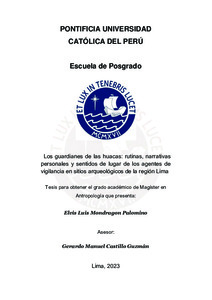| dc.contributor.advisor | Castillo Guzman, Gerardo Manuel | |
| dc.contributor.author | Mondragon Palomino, Elvis Luis | |
| dc.date.accessioned | 2023-05-09T18:22:05Z | |
| dc.date.available | 2023-05-09T18:22:05Z | |
| dc.date.created | 2023 | |
| dc.date.issued | 2023-05-09 | |
| dc.identifier.uri | http://hdl.handle.net/20.500.12404/24938 | |
| dc.description.abstract | Esta investigación desarrolla el tema de los agentes de vigilancia de los sitios
arqueológicos en la Región Lima, en particular se escogieron doce monumentos
arqueológicos: Huaycán de Pariachi, Cajamarquilla, Garagay, Paraíso, San Juan
de Pariachi, Monterrey, Bellavista, Palomino, Mangomarca, Huanchihuaylas,
Huaca San Borja y Bandurria; con la finalidad de llamar la atención a la sociedad
que estos actores han sido dejados de lado, olvidados, falta de reconocimiento
y sobre todo no vistos como parte del proceso de patrimonialización de los
monumentos arqueológicos. En ese sentido, esta investigación con un enfoque
cualitativo del tipo exploratorio, descriptivo y explicativo busca demostrar que los
agentes de vigilancia han construido una estrecha vinculación con el patrimonio
cultural de manera afectiva o apego. De este modo, se utiliza la técnica de las
entrevistas semiestructuradas, conversaciones informales, observación
participante y elaboración de dibujos para explorar de qué modo estos nuevos
actores construyen una experiencia de lugar en los monumentos arqueológicos
a partir del espacio material, prácticas cotidianas, trayectorias de vida, rutinas
espaciales, narrativas, y sentido de lugar para comprender su apego al lugar y
de algún modo visibilizar sus inquietudes y opiniones respecto a lo que están
realizando en el lugar. Finalmente, a grandes rasgos se ha logrado concluir que
efectivamente los agentes de vigilancia presentan un fuerte apego al lugar, es
decir al monumento arqueológico, y de este modo le dan un sentido. Todo esto
se da a través de la construcción de experiencias, en cuyo proceso se enlaza el
espacio material (sitios arqueológicos), educación, oficios, servicio militar,
lecciones de vida, reconocimientos, vida cultural, prácticas cotidianas,
autopercepción, interacción con las personas, satisfacciones, conciencia,
compromisos, sentimientos y recuerdos. Es decir, estos nuevos actores han
experimentado con gran parte de estos elementos emocionales, que le han
permitido un mayor apego al lugar, reflejado en su constancia por el cuidado del
patrimonio cultural. | es_ES |
| dc.description.abstract | This research develops the issue of security guards of archaeological sites in the
Lima Region, in particular twelve archaeological monuments were chosen:
Huaycán de Pariachi, Cajamarquilla, Garagay, Paraíso, San Juan de Pariachi,
Monterrey, Bellavista, Palomino, Mangomarca , Huanchihuaylas, Huaca San
Borja and Bandurria; with the aim of drawing attention to society that these actors
have been left aside, forgotten, lack of recognition and above all not seen as part
of the process of patrimonialization of archaeological monuments. In this sense,
this research with a qualitative approach of the exploratory, descriptive and
explanatory type, seeks to demonstrate that security guards have built a close
relationship with cultural heritage in an affective or attachment way. In this way,
the technique of semi-structured interviews, informal conversations, participant
observation and drawing drawings are used to explore how these new actors
build an experience of place in archaeological monuments from material space,
daily practices, trajectories of life, spatial routines, narratives, and sense of place
to understand their attachment to the place and in some way make visible their
concerns and opinions regarding what they are doing in the place. Finally, in
general terms it has been possible to conclude that the security guards do have
a strong attachment to the place, that is, to the archaeological monument, and in
this way, they give it a meaning. All this occurs through the construction of
experiences, in the process of which the material space (archaeological sites),
education, trades, military service, life lessons, recognition, cultural life, daily
practices, self-perception, interaction with people are linked, satisfactions,
conscience, commitments, feelings and memories. In other words, these new
actors have experimented with a large part of these emotional elements that have
allowed them to become more attached to the place, reflected in their
perseverance in caring for cultural heritage. | es_ES |
| dc.language.iso | spa | es_ES |
| dc.publisher | Pontificia Universidad Católica del Perú | es_ES |
| dc.rights | info:eu-repo/semantics/openAccess | es_ES |
| dc.rights.uri | http://creativecommons.org/licenses/by-nc-nd/2.5/pe/ | * |
| dc.subject | Patrimonio cultural--Protección--Perú--Lima | es_ES |
| dc.subject | Conjuntos arqueológicos--Perú--Lima | es_ES |
| dc.subject | Sitios históricos--Perú--Lima | es_ES |
| dc.subject | Guardia de seguridad--Perú--Lima | es_ES |
| dc.subject | Vigilantes--Perú--Lima | es_ES |
| dc.subject | Apego al lugar--Perú--Lima | es_ES |
| dc.title | Los guardianes de las huacas: rutinas, narrativas personales y sentidos de lugar de los agentes de vigilancia en sitios arqueológicos de la región Lima | es_ES |
| dc.type | info:eu-repo/semantics/masterThesis | es_ES |
| thesis.degree.name | Magister en Antropología | es_ES |
| thesis.degree.level | Maestría | es_ES |
| thesis.degree.grantor | Pontificia Universidad Católica del Perú. Escuela de Posgrado. | es_ES |
| thesis.degree.discipline | Antropología | es_ES |
| renati.advisor.dni | 07976242 | |
| renati.advisor.orcid | https://orcid.org/0000-0002-2854-5585 | es_ES |
| renati.author.dni | 40230512 | |
| renati.discipline | 315017 | es_ES |
| renati.juror | Damonte Valencia, Gerardo Hector | es_ES |
| renati.juror | Castillo Guzman, Gerardo Manuel | es_ES |
| renati.juror | Borea Labarthe, Giuliana | es_ES |
| renati.level | https://purl.org/pe-repo/renati/level#maestro | es_ES |
| renati.type | https://purl.org/pe-repo/renati/type#tesis | es_ES |
| dc.publisher.country | PE | es_ES |
| dc.subject.ocde | https://purl.org/pe-repo/ocde/ford#5.04.03 | es_ES |







